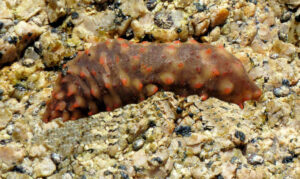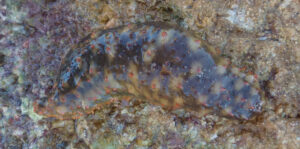California Sea Cucumber, Apostichopus californicus
 California Sea Cucumber, Apostichopus californicus. Length: 15 cm (5.9 inches). Sea Cucumber collected from coastal waters off San Diego, California, August 2010.
California Sea Cucumber, Apostichopus californicus. Length: 15 cm (5.9 inches). Sea Cucumber collected from coastal waters off San Diego, California, August 2010.
 California Sea Cucumber, Apostichopus californicus. Length: 18 cm (7.1 inches). Sea Cucumber collected from coastal waters off San Diego, California, July 2013.
California Sea Cucumber, Apostichopus californicus. Length: 18 cm (7.1 inches). Sea Cucumber collected from coastal waters off San Diego, California, July 2013.
Phylogeny: The California Sea Cucumber, Apostichopus californicus (Stimpson, 1857), is a member of the Spiky Sea Cucumber or Stichopodiidea Family. It is also reffered to as the Giant Sea Cucumber and in Mexico as pepino de mar California.
Morphology: The California Sea Cucumber is covered with reddish-brown, white or yellow leathery skin. Their bodies are large and cylindrical with a flattened ventral surface. The mouth is surrounded by 20 retractable tentacles that are utilized to procure food. They are covered with large, stiff, conical papillae that have red tips and are lighter in color than the rest of the body. There are five rows of tube feet along the ventral surface that extend from the mouth to the anus. California Sea Cucumbers are the largest Sea Cucumber on the Pacific Coast and reach widths of 5.0 cm (2.0 inches), lengths of 50 cm (19.7 inches), and weights of 225 grams (0.5 lbs).
Habitat and Distribution: The California Sea Cucumber resides within mud, rocks, and sand substrate in the intertidal zone to depths up to 250 m (820 feet). They are most abundant in areas with moderate currents and bedrock, boulders, and cobbles. The California Sea Cucumber is a resident of the Pacific Ocean but has a limited range from Cedros Island, Baja California northward along the central and northwest coasts of Baja.
Diet: The California Sea Cucumber is a solitary, nocturnal animal, that emerge to scavenge on organic detritus and small organisms. They can also take up nutrients via the anus.
Predators: The California Sea Cucumber are preyed upon by sea otters, sea stars, fish, crabs, and humans.
Reproduction: The California Sea Cucumber reach sexual maturity at four years Reproduction involves separate sexes with external fertilization with each female releasing thousands of eggs. Metamorphose of larvae into a sea cucumber occurs in a couple of weeks.
Behavior: The California Sea Cucumber has the ability, when threatened, to expel its organs through its anus and can fairly quickly re-grow nearly all of their internal organs.
Life Cycle: The California Sea Cucumber reaches sexual maturity at four years old and separate sexes develop. Younger sea cucumbers often appear more pale in color and are thinner.
Ecosystem Role: The California Sea Cucumber has a commensal relationship with the Red Commensal Scale Worm, Arctonoe pulchra.
Endangerment Status: The California Sea Cucumber is currently considered to be of Least Concern with stable, widely distributed populations. They are fished by artisanal fishermen and sold commercially. They are also raised by aquaculture.
Common Misidentification: The California Sea Cucumber can be confused with the Warty Sea Cucumber, Apostichopus parvimensis. However, this species is differentiated by a chestnut brown body and pale ventral side. The tips of the papillae are black unlike the red-tipped papillae of the California Sea Cucumber.
Synonyms: Holothuria californica, Parastichopus californicus, Stichopus californicus.